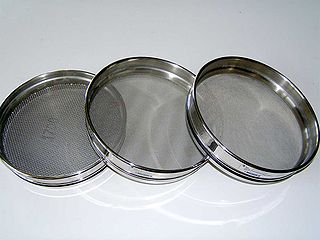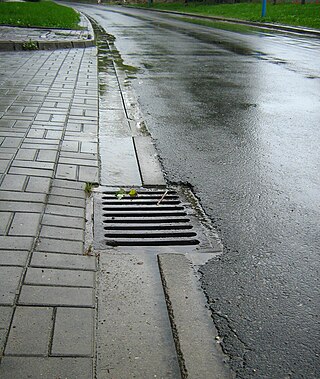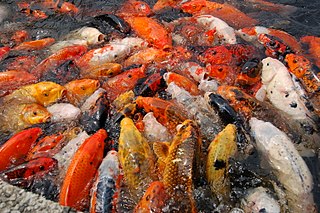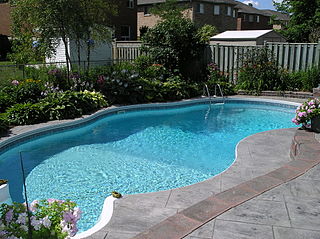
Ocean Thermal Energy Conversion (OTEC) uses the ocean thermal gradient between cooler deep and warmer shallow or surface seawaters to run a heat engine and produce useful work, usually in the form of electricity. OTEC can operate with a very high capacity factor and so can operate in base load mode.

A dishwasher is a machine that is used to clean dishware, cookware, and cutlery automatically. Unlike manual dishwashing, which relies heavily on physical scrubbing to remove soiling, the mechanical dishwasher cleans by spraying hot water, typically between 45 and 75 °C, at the dishes, with lower temperatures of water used for delicate items.

A dehumidifier is an air conditioning device which reduces and maintains the level of humidity in the air. This is done usually for health or thermal comfort reasons, or to eliminate musty odor and to prevent the growth of mildew by extracting water from the air. It can be used for household, commercial, or industrial applications. Large dehumidifiers are used in commercial buildings such as indoor ice rinks and swimming pools, as well as manufacturing plants or storage warehouses. Typical air conditioning systems combine dehumidification with cooling, by operating cooling coils below the dewpoint and draining away the water that condenses.

A sieve, fine mesh strainer, or sift, is a device for separating wanted elements from unwanted material or for controlling the particle size distribution of a sample, using a screen such as a woven mesh or net or perforated sheet material. The word sift derives from sieve.

A storm drain, storm sewer, surface water drain/sewer, or stormwater drain is infrastructure designed to drain excess rain and ground water from impervious surfaces such as paved streets, car parks, parking lots, footpaths, sidewalks, and roofs. Storm drains vary in design from small residential dry wells to large municipal systems.

Water cooling is a method of heat removal from components and industrial equipment. Evaporative cooling using water is often more efficient than air cooling. Water is inexpensive and non-toxic; however, it can contain impurities and cause corrosion.
A hydraulic accumulator is a pressure storage reservoir in which an incompressible hydraulic fluid is held under pressure that is applied by an external source of mechanical energy. The external source can be an engine, a spring, a raised weight, or a compressed gas. An accumulator enables a hydraulic system to cope with extremes of demand using a less powerful pump, to respond more quickly to a temporary demand, and to smooth out pulsations. It is a type of energy storage device.

A cooling tower is a device that rejects waste heat to the atmosphere through the cooling of a coolant stream, usually a water stream to a lower temperature. Cooling towers may either use the evaporation of water to remove process heat and cool the working fluid to near the wet-bulb air temperature or, in the case of dry cooling towers, rely solely on air to cool the working fluid to near the dry-bulb air temperature using radiators.

Frazil ice is a collection of loose, randomly oriented ice crystals millimeter and sub-millimeter in size, with various shapes, e.g. elliptical disks, dendrites, needles and of an irregular nature. Frazil ice forms during the winter in open-water reaches of rivers as well as in lakes and reservoirs, where and when the water is in a turbulent state, which is, in turn, induced by the action of waves and currents. Turbulence causes the water column to become supercooled, as the heat exchange between the air and the water is such that the water temperature drops below its freezing point. The vertical mixing associated with that turbulence provides enough energy to overcome the crystals' buoyancy, thus keeping them from floating at the surface. Frazil ice also forms in oceans, where windy conditions, wave regimes and cold air also favor the establishment of a supercooled layer. Frazil ice can be found on the downwind side of leads, and in polynyas. In these environments, that ice can eventually accumulate at the water surface into what is referred to as grease ice.

A sump pump is a pump used to remove water that has accumulated in a water-collecting sump basin, commonly found in the basements of homes. The water may enter via the perimeter drains of a basement waterproofing system, funneling into the basin or because of rain or natural ground water, if the basement is below the water table level.

Marine debris, also known as marine litter, is human-created waste that has deliberately or accidentally been released in a sea or ocean. Floating oceanic debris tends to accumulate at the center of gyres and on coastlines, frequently washing aground, when it is known as beach litter or tidewrack. Deliberate disposal of wastes at sea is called ocean dumping. Naturally occurring debris, such as driftwood and drift seeds, are also present. With the increasing use of plastic, human influence has become an issue as many types of (petrochemical) plastics do not biodegrade quickly, as would natural or organic materials. The largest single type of plastic pollution (~10 %) and majority of large plastic in the oceans is discarded and lost nets from the fishing industry. Waterborne plastic poses a serious threat to fish, seabirds, marine reptiles, and marine mammals, as well as to boats and coasts.

Bioswales are channels designed to concentrate and convey stormwater runoff while removing debris and pollution. Bioswales can also be beneficial in recharging groundwater.

Koi ponds are ponds used for holding koi carp, usually as part of a garden. Koi ponds can be designed specifically to promote health and growth of the Nishikigoi or Japanese Ornamental Carp. Koi ponds or lakes are a traditional feature of Japanese gardens, but many hobbyists use special ponds in small locations, with no attempt to suggest a natural landscape feature.

A fish screen is designed to prevent fish from swimming or being drawn into an aqueduct, cooling water intake, intake tower, dam or other diversion on a river, lake or waterway where water is taken for human use. They are intended to supply debris-free water without harming aquatic life. Fish screens are typically installed to protect endangered species of fishes that would otherwise be harmed or killed when passing through industrial facilities such as steam electric power plants, hydroelectric generators, petroleum refineries, chemical plants, farm irrigation water and municipal drinking water treatment plants. However, many fish are killed or injured on screens or elsewhere in the intake structures.

An automated pool cleaner is a vacuum cleaner that is designed to collect debris and sediment from swimming pools with minimal human intervention.

A rain gutter, eavestrough, eaves-shoot or surface water collection channel is a component of a water discharge system for a building. It is necessary to prevent water dripping or flowing off roofs in an uncontrolled manner for several reasons: to prevent it damaging the walls, drenching persons standing below or entering the building, and to direct the water to a suitable disposal site where it will not damage the foundations of the building. In the case of a flat roof, removal of water is essential to prevent water ingress and to prevent a build-up of excessive weight.
An oil skimmer is a device that is designed to remove oil floating on a liquid surface from oil spills. The effectiveness of a skimmer is highly dependent on the roughness of the surrounding water that it is working on, the more choppy the surrounding wake and water the more water the oil skimmer will take in rather than just oil. Skimmers are either self propelled, used from shore or operated from vessels depending on the oil spill scenario. Depending on these specific designs they are used for a variety of applications other than oil spills such as a part of oily water treatment systems, removing oil from machine tool coolant and aqueous parts washers, and collecting fats oils and greases in wastewater treatment in food manufacturing industries.
Swimming pool sanitation is the process of ensuring healthy conditions in swimming pools. Proper sanitation is needed to maintain the visual clarity of water and to prevent the transmission of infectious waterborne diseases.

A swimming pool, swimming bath, wading pool, paddling pool, or simply pool, is a structure designed to hold water to enable swimming or other leisure activities. Pools can be built into the ground or built above ground, and may be found as a feature aboard ocean-liners and cruise ships. In-ground pools are most commonly constructed from materials such as concrete, natural stone, metal, plastic, or fiberglass, and can be of a custom size and shape or built to a standardized size, the largest of which is the Olympic-size swimming pool.

Ice drilling allows scientists studying glaciers and ice sheets to gain access to what is beneath the ice, to take measurements along the interior of the ice, and to retrieve samples. Instruments can be placed in the drilled holes to record temperature, pressure, speed, direction of movement, and for other scientific research, such as neutrino detection.


















